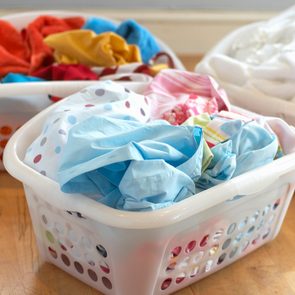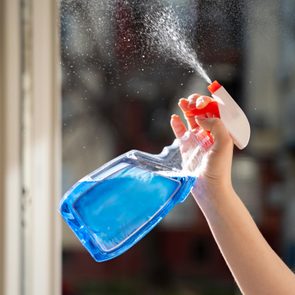How to Get Rid of Sweat Stains, According to Experts
Updated: Jul. 19, 2024

Don’t toss those sweat-stained items! Remove yellow armpit stains and accompanying odors with a few simple tricks and save your wardrobe.
Like it or not, sweat stains are a thing. Whether you work out or you simply run hot, those telltale yellow marks are inevitable, so it’s important to know how to remove the stains to keep your wardrobe looking (and smelling) fresh. To find out how to remove sweat stains from any kind of laundry, Reader’s Digest spoke to two laundry and cleaning experts: Mary Johnson, a principal scientist at Tide with more than 20 years of experience, and Melissa Maker, the founder of the housekeeping service Clean My Space.
When there are sweat stains on clothes, “It doesn’t mean anyone is grosser than another person,” says Maker. “They’re a fact of life, and everyone experiences sweat stains in varying degrees.” Even if you use antiperspirants and deodorants, perspiration can still leave stinky odors on clothes. But don’t toss your discolored or otherwise problematic items—if you learn how to wash out sweat stains and remove odors from clothes, you can save your wardrobe. All it takes is a few simple tricks.
Get Reader’s Digest’s Read Up newsletter for more cleaning, humor, travel, tech and fun facts all week long.
|
On This Page About the experts
|
What causes sweat stains?

Sweat is made up of a combination of water, salt, fats and proteins, so when you perspire, all these things go into your clothes. “If you don’t wash your clothes after each wear with a high-quality detergent, they can build up over time with each subsequent wear and become deeply embedded between the fabric fibers,” says Mary Johnson, principal scientist at Tide. “Over time, these soils can actually bind to the fabric fibers to cause yellowing, and as they break down into smaller, airborne molecules, they become very stinky.”
Your body’s perspiration can also combine with certain ingredients in your deodorant or antiperspirant, like aluminum and zirconium. This can wreak havoc on your clothes over time and cause yellowing, since the product is concentrated in one spot and gets ground into the fabric. Using an aluminum-free deodorant can help with this problem, as can making sure your deodorant or antiperspirant is completely dry before you put on your shirt.
Body oils contribute to staining too. “Normally, sweat on its own won’t stain clothes,” Johnson explains, “but it’s the combination of sweat and body oils that will turn clothes yellow over time.” That’s why it’s so important to wash your items regularly and thoroughly and know how to remove stains before they set in.
Can sweat stains be removed?
Over time, untreated sweat stains can become stubborn and difficult to remove. But if you promptly treat the garment, sweat marks don’t have to stain your clothes permanently.
Supplies you’ll need
- Laundry detergent
- White vinegar
- Baking soda
- Hydrogen peroxide
- Stain spot treatment
How to get sweat stains out of white shirts

White shirts are the most likely pieces of clothing to be affected by yellow, sometimes stinky sweat stains. Follow these steps to wash white clothes to get the stains out.
Directions
- Rinse the garment in warm water to dilute the stain, advises Johnson.
- Pre-treat the soiled spots, either with a mixture of your regular detergent and white vinegar, or a paste of baking soda and either water or hydrogen peroxide. Melissa Maker, host of Clean My Space on YouTube, suggests one part baking soda to two parts water or hydrogen peroxide.
- Let the garment sit for as little as 20 minutes or as long as overnight, depending on the severity of the stains.
- Without washing off the pre-treatment, throw the garment into the laundry with other items and wash with regular detergent. If the care label allows, wash in warm water. Otherwise, wash in cold water.
- If the stain is still there, repeat these steps before drying the garment.
How to get sweat stains out of colored shirts

When it comes to removing sweat stains and stink from colored shirts, you’ll largely be following the same steps as you would with a white shirt.
Directions
- Rinse your colored shirt in warm water to dilute the stain.
- Pre-treat the affected areas with a mixture of detergent and white vinegar, suggests Johnson, or a paste of baking soda and water. “Do one part baking soda to two parts water,” says Maker.
- Let the garment sit for as little as 20 minutes or as long as overnight, depending on the severity of the stains.
- Without washing off the pre-treatment, throw the garment into the laundry with other items and wash with regular detergent. If the care label allows, wash in warm water. Otherwise, wash in cold water.
- If the stain is still there, repeat the steps above before putting the shirt into the dryer.
Tip: If you opt for the baking-soda paste, use water instead of hydrogen peroxide, suggests Maker, in order to protect the color. “If you’re nervous, test a small, hidden area before you do the whole garment,” she says.
How to remove ring-around-the-collar stains

Stains on the collar are often caused by both sweat and makeup, aftershave, face cream, lotion or another product you’re using on that area of your skin. “You want to be sure you treat the stain first, and then worry about the ring around the collar after,” says Maker.
For the stain, a spot treatment works well. “You can even use laundry detergent as a pre-treatment,” says Maker.
Directions
- Rinse the garment in warm water to dilute the stain.
- Pre-treat the stain with a spot treatment, like laundry detergent or a specialized stain-removing spray. (One good option: OxiClean Laundry Stain Remover.)
- Let the stain remover dwell on the fabric for as little as 20 minutes or as long as overnight, depending on the severity of the stain.
- Without washing off the pre-treatment, throw the shirt into the laundry and wash with regular detergent. If the care label allows, wash in warm water. Otherwise, wash in cold water.
- If the stain is still there, repeat the steps above before drying the shirt.
How to get the sweat smell out of clothes

Daily sweat or the extra sweating caused by heat or physical activity comes from your skin’s eccrine glands. It’s actually 99% water, and it doesn’t smell that bad, explains Johnson.
“In contrast, stress sweat comes from the apocrine gland in your skin and contains 20% fats and proteins and smells really awful, because the fats and proteins in sweat can break down into small, very stinky molecules to produce a body odor smell,” she says.
Even though you can’t always see body soils on garments, they need to be removed thoroughly with a high-quality detergent or you will experience odors that come back even after washing.
Here’s how to remove those stubborn smells once they’ve set in.
Directions
- Using a plastic bucket, create a soak solution by adding a half-dose of laundry detergent per gallon of warm water.
- Allow the garment to soak for up to 30 minutes. For an added benefit, add a white towel on top of the stained garment in the bucket to help keep it submerged in the solution.
- Next, wash the garment in warm water with one dose of the appropriate amount of detergent based on the wash load size. For tough odors, also include an odor remover, like Tide Odor Rescue.
- If the odor remains, repeat these steps before drying.
How to get sweat stains out of hats

Again, this process is similar to all the rest, but as with colored shirts, you don’t want to use hydrogen peroxide, since that can mess with colors in the hat, explains Maker.
Directions
- Rinse the hat in warm water.
- Pre-treat with a mixture of detergent and white vinegar, or a paste of baking soda and water (one part baking soda to two parts water).
- Let it sit for at least 20 minutes or overnight, depending on the severity of the stains.
- Without washing off the pre-treatment, throw the hat into the laundry with other items and wash with regular detergent. If the care label allows, wash in warm water. Otherwise, wash in cold water.
- If the stain is still there, repeat the steps above before drying.
Tip: One type of hat that can be tricky to wash is a baseball hat. Here’s how to wash a baseball hat so it doesn’t lose its shape.
How to get rid of sweat stains with unexpected household items

Think of these solutions as the MacGyvers of sweat stain removal. They’re surprising, yes, but they can work—and even better, you probably already have them in your pantry. Follow the appropriate steps for the stain-removing product of your choice, and then throw the item of clothing into the laundry.
Meat tenderizer
A meat tenderizer probably isn’t the first thing you’d think of when figuring out how to remove sweat stains, but you can tenderize away hard-to-remove stains. Before you wash that damaged sweatshirt, dampen the armpit stain and sprinkle some meat tenderizer on it. Then just wash as usual.
Aspirin
Those yellow sweat stains can certainly give you a headache, and aspirin can help in an unexpected way. Crush two aspirin tablets, and mix the powder in half a cup of warm water. Soak the stained part of the garment in the solution for two to three hours, then wash as normal.
Dish soap
Mix one part dish soap with two parts hydrogen peroxide, then scrub the stain and let it sit for an hour. Dish soap works well on oil stains too, as it’s created to cut through grease and oil.
Salt
Salt’s another secret ingredient for getting rid of those stubborn yellow pit stains. Dissolve four tablespoons of salt in one quart (one liter) of hot water. Sponge the garment with the solution until the stain disappears.
Lemons
Avoid expensive dry-cleaning bills! Remove unsightly underarm stains from blouses by scrubbing them with a mixture of equal parts lemon juice and water. The citrus works as a stain fighter, but it’s gentle enough not to damage your more delicate garments.
Vinegar
Pour a bit of vinegar directly onto the stain and rub it into the fabric before placing the item in the wash. You can also remove deodorant stains from your washable shirts and blouses by gently rubbing the spot with undiluted vinegar before laundering.
Baking soda
Pre-treating clothes with a paste made from four tablespoons baking soda and one-fourth cup warm water can help vanquish a variety of stains, including perspiration stains. For really awful stains, let the paste dry for about two hours before washing. For collar stains, rub in the paste and add a bit of vinegar before putting the shirt in the wash.
Ammonia
Rub out perspiration and even blood stains by dabbing the area with a half-strength solution of ammonia and water before laundering. Ammonia is an excellent way to get rid of sweat stains—but you should never mix it with bleach, since the combination of the two products can cause toxic fumes.
Vodka
Cheers to creative sweat-stain removal! Yes, equal parts vodka mixed with warm water could help remove sweat stains, thanks to the alcohol content in the vodka. Spray the odor or stain with the mixture before machine-washing.
Borax
Although you shouldn’t use it on delicate fabrics, borax is an effective product that can help remove sweat stains. All you need is one tablespoon of this powder mixed with a little water to turn it into a paste. Apply it to the affected area and leave it on for 30 minutes before scrubbing it off and washing the clothing as usual.
The keys to keeping your clothes fresh and clean

To keep your clothes from becoming super stinky and sweat stained in the first place, follow these tips from Johnson.
- When possible, after heavy workouts or particularly stressful days, rinse off gear under warm running water and allow it to air-dry before placing it in the hamper.
- Never leave wet or damp workout clothes or towels in a warm, dark place like a gym bag or laundry hamper. They can start to smell like mildew or mold in as little as six hours.
- Always take your workout clothes or towels out of your gym bag and let them fully air-dry before placing them in your laundry hamper to prevent the mildew/mold smell.
Why trust us
At Reader’s Digest, we’re committed to producing high-quality content by writers with expertise and experience in their field in consultation with relevant, qualified experts. For this piece, Amy Schlinger tapped her experience writing about clothing stain removal, and then Mary Marlowe Leverette, a fabric-care, stain-removal and laundry expert with more than 40 years of industry experience, gave it a rigorous review to ensure that all information is accurate and offers the best possible advice to readers. We verify all facts and data, back them with credible sourcing and revisit them over time to ensure they remain accurate and up to date. Read more about our team, our contributors and our editorial policies.
Sources:
- Melissa Maker, host of Clean My Space on YouTube and founder of the housekeeping service Clean My Space; interviewed Feb. 2021
- Mary Johnson, principal scientist at Tide; interviewed Feb. 2021























